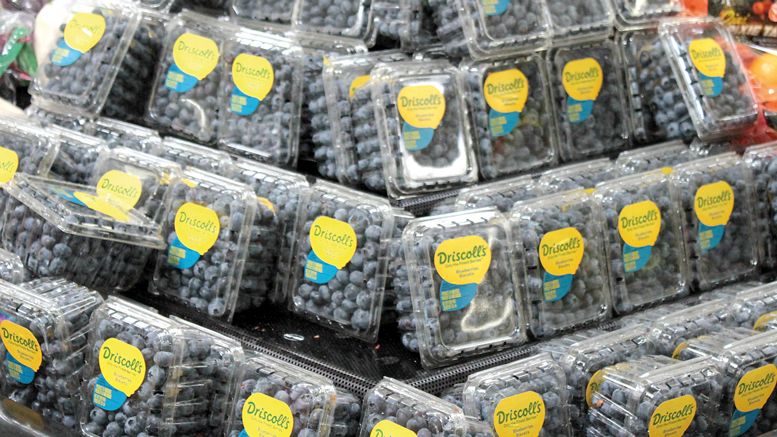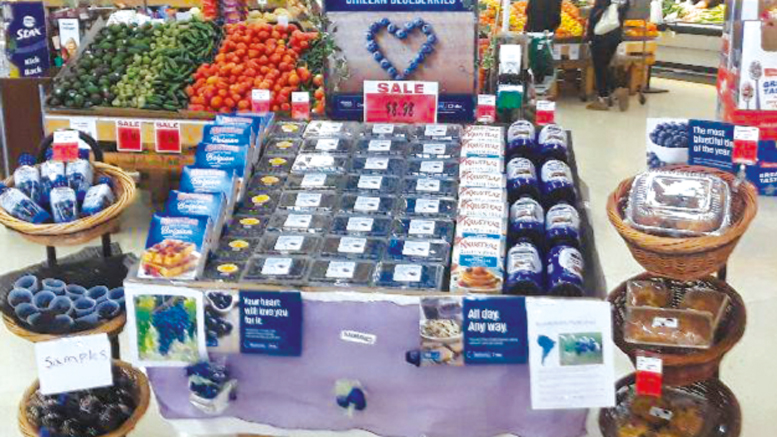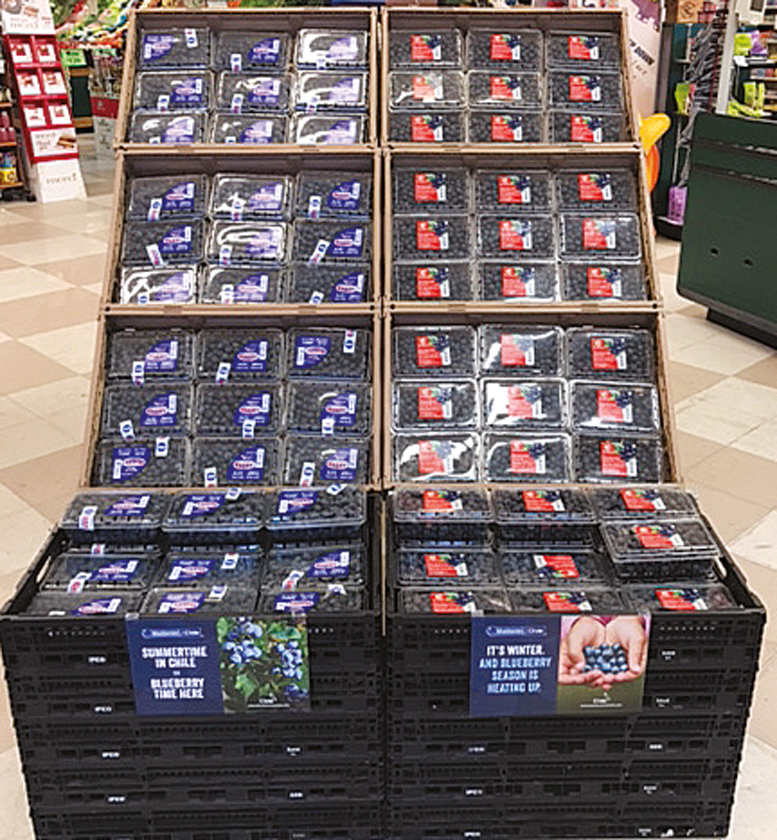Global production efforts show berries have become viable year-round in terms of availability and pricing.
After overtaking Chile as the world’s leading fresh blueberry exporter in 2019, Peru is gearing up for another massive rise in volume in 2020-21. Meanwhile, North America’s imports of strawberries, blackberries and raspberries continue to grow despite COVID-19 disruptions in the spring.
Lima-based Peruvian blueberry association, ProArándanos, is forecasting a whopping 42.5% rise in volume this season to more than 171,000 metric tons (MT), most of which is exported with a window from June through March.

Luis Miguel Vegas, manager of ProArándanos, says exports globally will likely rise by around 40%, although the percentage rise destined for North America will be pronounced but not as high.
“The USA is the biggest market for Peru, and for this year in the American market — including Canada — we’re forecasting a 25% rise in volume compared to the past season,” says Vegas. “Our peak week will be in mid-October, but that is when the fruit leaves Peru, so the berries should be reaching the American market at the beginning of November right after Halloween.”
Soren Bjorn, president of Driscoll’s of the Americas, based in Watsonville, CA, describes the incoming volumes from Peru as “unprecedented.” He is optimistic about strong demand and expects more of a complementary effect on other berries rather than cannibalization. “We have never seen anything like that in the history of the berry industry, where you’re seeing this kind of increase year-over-year on what is already a very large business.”
Significant Changes
It is a development set against a backdrop of significant changes in the berry category more broadly, notwithstanding a few setbacks earlier this year. Juan Jose Flores, director of Mexico’s National Association of Berry Exporters (Aneberries), notes strawberry shipments were practically unscathed by COVID-19 as the program was over just before the pandemic hit. He says blueberries also fared relatively well, and even though there were disruptions for raspberries and blackberries, they still held stable.
“We believe it’s clear to consumers that berries are a nutritious food with a lot of antioxidants that strengthen the immune system, so consumption stayed similar to what it was in the 2018-19 season,” says Flores. “There was a fall in price, but we were helped by the exchange rate so our income in pesos was maintained.”
Unlike Peru, however, Flores says Mexico’s berry export growth rate to the U.S. is likely to fall to single digits in the months ahead year-over-year. “We had been growing at double digit rates above 10% on average, and in blueberries we were growing at 22% on average annually,” he says. “Now I think we’ll grow by 5% or 6%. In the case of raspberries and blackberries, it’s a similar situation to blueberries. There’s not going to be growth that’s any higher than 5% or 6%, and I think strawberries will stay similar to last season.”

PHOTO COURTESY OF THE CHILEAN FRESH FRUIT ASSOCIATION
Bjorn of Driscoll’s says the drop-off in foodservice meant berries needed to be in double-digit volume growth at retail to compensate, but there have been some encouraging signs recently. “Back in April we were really challenged in trying to sell everything that was coming. We actually couldn’t sell all the raspberries and blackberries in certain weeks,” he says.
“Lately we are seeing that berries are beginning to outperform overall produce sales, which we did not see until the middle of July,” Bjorn explains. “I would say the demand looks very promising for the import season, unlike what it looked like in the springtime.”
Rob Russo, general manager of Dole Diversified, North America, based in Charlotte, NC, saw a large drop in the sales of items that are typically more impulse-driven in the first three weeks of April.
“Staple items like blueberries and strawberries did not see a negative impact early on,” says Russo. “Labor was a major issue in production, as many workers live in other locations and chose to return home to be with family.”
Jason Fung, vice president of berry and greenhouse categories at Oppy in Vancouver, BC, Canada, says shopping patterns have shifted during the pandemic, and that is likely to continue for the near future. “This meant the industry has had to adjust to these dynamics while managing COVID-19’s operational impact on the supply side, all while balancing that out with our normal, mother-nature-driven swings in the berry category,” says Fung, whose company partners with Ocean Spray in its berry program.
“Certainly the pace of growth, the entrepreneurial spirit, the commitment to quality partnerships and growing practices have continued to impress us throughout Mexico and South America,” observes Fung. “As new projects in new areas that may not have supported large scale berry growing before emerge, we are excited about what the opportunities represent to us, our grower partners and our retailers.”
Supply Gaps Closed
Excitement is a common emotion with major berry industry players who have both driven and witnessed enormous growth during the past decade. In 2010 for example, UN Comtrade statistics show Peru only exported 6MT of blueberries.
In the 2019 calendar year, the U.S. imported $3.59 billion worth of berries overall, compared to $965 million in 2010.

PHOTO COURTESY OF THE CHILEAN FRESH FRUIT ASSOCIATION
Bjorn of Driscoll’s says the berry import industry has gone hand-in-hand with domestic industry growth, which has instilled higher consumption habits across the berry category. “Of course, imports are increasing much faster but that’s because Peru didn’t exist 10 years ago as an industry, and Mexico was irrelevant as an industry,” says Bjorn.
The Driscoll’s executive laments there is a formal International Trade Commission (ITC) investigation into potential impacts from imported blueberries on domestic growers, but emphasizes imports have benefited the sector overall. ““It’s very clear the imported blueberries are what have made the blueberry industry as we know it today possible, because without the imported blueberries, supply wouldn’t be year-round,” Bjorn explains. “With a year-round availability, we have gone from 20 years ago when U.S. consumers annually consumed 100g [about 2/3 cup] of blueberries and today they consume almost 1kg [6.76 cups] of blueberries. The data is very clear, that flavor and quality trump origin anytime.”
These sentiments are also shared by Vegas of ProArándanos in Peru, whose organization is part of the U.S. Highbush Blueberry Council (USHBC). He hopes promotional efforts will get blueberries on Americans’ shopping lists, with stable supply leading to habitual purchases. “What’s more important than origin is to increase consumption of blueberries in the United States,” says Vegas.
Bjorn is enthusiastic about numerous developments that will both lead to more consistent supply in combination with the constant quest for flavorful berry varieties that are delightful to eat. He highlights a few factors including significant expansion in blackberries in Mexico boosted by improved genetics, expectations for a very good Mexican raspberry season, and the introduction of new strawberry varieties in Mexico as well as Florida.
“One of the things you’re going to see over time is the winter supply of berries significantly improving in quality and availability,” says Bjorn. “What you saw historically with the summer business is now truly a year-round business, and it’s going to become increasingly year-round in terms of pricing.”
Russo of Dole recommends retailers continue to promote berries year-round, as production supply gaps have been closed and there is now ample volume 52 weeks a year. “For blueberries, we used to have supply gaps from September to November and March to April. Peru and Mexico are filling these gaps now,” he says.
“Changes that we are seeing involve consumers shopping just one store and not going store-to-store buying what’s on ad. From that standpoint, customers are aligning with suppliers that execute high fill rates and are priced fairly,” says Russo.
As far as Chilean supply overtaking Peru in terms of volume, Russo says given both suppliers have different peak periods, volumes have not been particularly impacted for the former import market leader. “Argentina on the other hand is being squeezed out by Peru,” he says. “Argentina also air ships product to the States, but with fewer flights and therefore less availability, airfreight costs are up 30%.”
“Mexico continues to increase production, which over time may impact South American imports,” Russo adds, explaining most Mexican suppliers plan to ship in March-April between when South American supply ends and when the U.S. is just starting.”
Carla Ginobili, manager of the Argentinian Blueberry Committee (ABC), says only 2% to 3% of her country’s volumes were exported by sea in 2014, but that percentage rose to 35% last year.
“In the midst of the pandemic where there will be fewer passenger flights, it is predicted that only 30% of the fruit will be shipped via airfreight,” says Ginobili. “In recent years, exports from Argentina have stabilized at around 15,000MT [worldwide], representing 10% of supply in the August to December window in 2019. So we’ve tried to become a niche player with comparative advantages and differentiating values.”
She says there are three pillars to Argentina’s differentiation strategy: flavor, responsible labor and organic production, with organics accounting for close to a third of total supply.
In the 2019 calendar year, the U.S. imported $3.59 billion worth of berries overall, compared to $965 million in 2010.
In terms of marketing, the ABC is running its fourth campaign with the slogan “Taste the Sweetness & Enjoy the Difference.” Ginobili clarifies around 60% of Argentina’s blueberry exports go to the U.S. and Canada
Brian Bocock, vice president of product management at Naturipe Farms in Salinas, CA, says his company has expanded production in Peru and Mexico to close any domestic gaps in the lighter months as well. “We’ll rely on Peru, Argentina and Chile to carry us into 2021 where Mexico will then take over until the domestic season picks up once again,” says Bocock. “We’ll source our blackberries domestically throughout October, and then Mexico will lead us until the end of April.”
Bocock adds, “California raspberries will produce until the end of December before Mexico’s peak season begins. We’re producing new varieties that are allowing for an increase in volume of raspberries.”
He notes the ideal climate for strawberry production in California with a good range of micro-climates and “best-in-class” production per acre mean the state can cultivate the crop for most of the year. “The opportunity for imports is not as pronounced as it may be in raspberries, blackberries and blueberries for imports,” he says. “Mexico does have a production window during the winter months when California struggles to get great yields per acre.”
Chile Remains A Major Force
With Vegas of ProArándanos estimating Peru will have 13,000 hectares (32,124 acres) in production by the end of 2020 and more production expansion in the pipeline, it would be easy to see this rapid growth as a threat to Chile. But in fact, a good part of Peru’s growth has been thanks to Chilean expertise and investment. Andrés Armstrong, manager of the Chilean Blueberry Committee (CBC), says Chilean companies are exploring production growth in Peru as well as Mexico.
Armstrong explains Chilean growers are working to improve productivity, and overall the committee is forecasting 2% growth for the country’s blueberry exports in 2020-21, surpassing 111,500MT along with a further 42,5000MT in frozen blueberries.
“This growth comes from the fact that Chilean growers are renewing their varieties with better shelf life and also getting rid of those that no longer provide commercial opportunities,” Armstrong explains. “So, in general terms, blueberry exports from Chile remain within the same volumes as the previous three seasons, but with a better varietal mix.”
“This production will get into the different markets in the traditional window for Chile from mid-December to mid-March,” he says, clarifying shipments from northern Chile will reach international markets from mid-October, and the country’s organic program continues to grow.
Karen Brux, managing director for the Chilean Fresh Fruit Association (CFFA) in San Carlos, CA, highlights a marketing program that will focus on giving retailers the support they need to effectively merchandise and promote fruit under the branding, “Blueberries from Chile.”
“In light of COVID-19, this will likely focus on digital promotions. Digital coupons, web banners, Facebook Live sessions with retail dietitians and online newsletters are just some of the ways we’ll work with retailers to drive Chilean blueberry sales,” says Brux. “Some retailers were already running these programs pre-COVID, and others have put them in place during the past several months.”
Brux adds Fruits from Chile has a very strong social media presence, with 530,000 fans on its Facebook page, more than 35,000 followers on Instagram and 25,000 subscribers to its e-newsletter.
“These are all great channels for communicating with consumers and raising the level of excitement around blueberries through contests and promotions,” she says. “Of course, as in-store opportunities increase, we will also explore these. It’s certainly ideal if we can reach shoppers both prior to and at the point of purchase.”
30/10/2020

